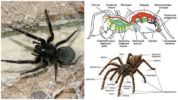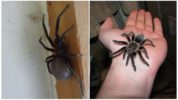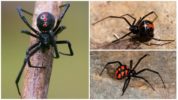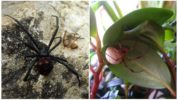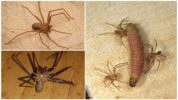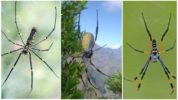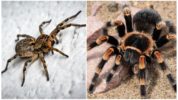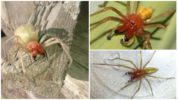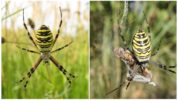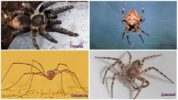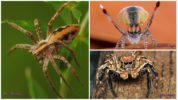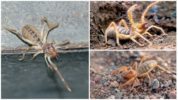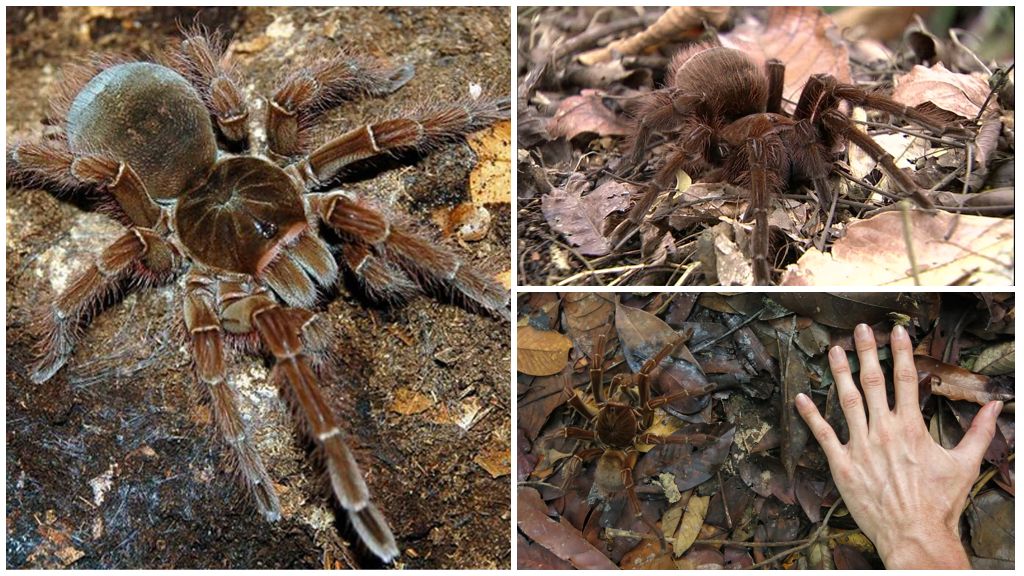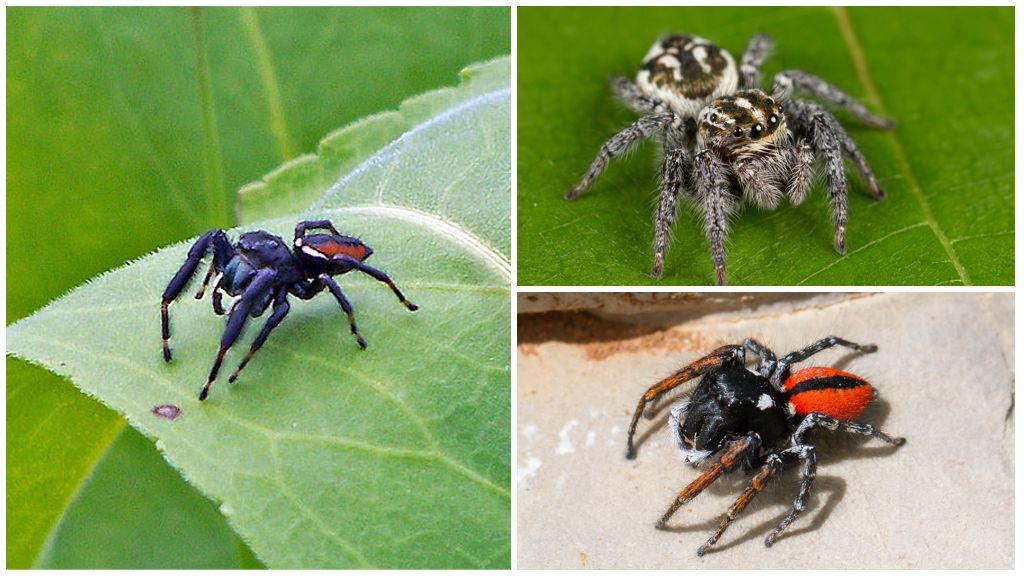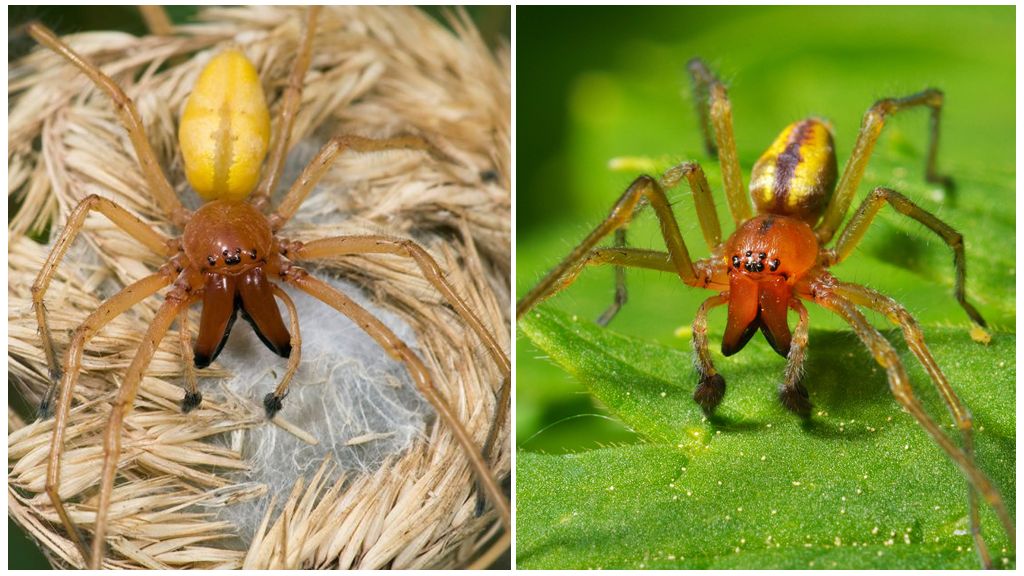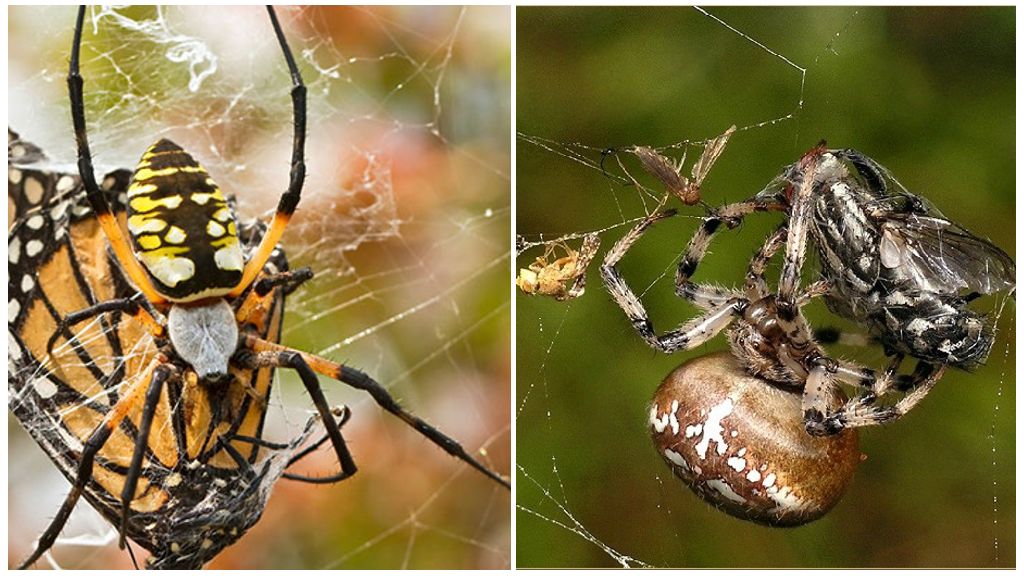- General morphology
- Internal structure
- Food spiders
- What are the spiders
- Funny classification
- Deadly poisonous
- North American Black Widow
- South American Black Widows
- Karakurt
- Oceania and Australia
- Latrodectus geometricus
- Brazilian wandering spider
- Hermit spider
- Spiders of medium toxicity
- Banana
- Tarantulas
- Spider sak
- Argiope
- Safe spiders
- Tarantulas
- Crosses
- Hayers
- Brownie
- Horses
- Peacock spider
- Tramp
- Hunter
- Green spider
- Crab spider
- Arachnids
- Spider structure
- Spiders
- North American Black Widow
- Karakurt black and white
- Brazilian wandering spider
- Hermit spider
- Large Tree Spider Orb
- Tarantulas
- Spider sak
- Argiope
- Types of Safe Spiders
- Types of Safe Spiders
- Solpuga
Spiders are a rare exception in nature when a whole squad of animals are obligate predators. All species of spiders, except one, feed only on living organisms, which they themselves catch. Dead insects and small animals are not interested in arthropods.
On a note!
Scientists believe that there are 42 thousand species of spiders living on the planet today. But how many spiders in the world, in fact, no one can say for sure. Small species of animals are discovered almost every year today, and on the planet there are still quite a few explored forests and jungles. Spiders are masters of disguise.
Species of spiders differ from each other in size, length of paws, shape and size of chelicera, poisonous. The spider can be bristled or smooth. Can weave a spider web or dig minks. But all species of spiders have common signs that allow them to be attributed to the order of arachnids.
General morphology
The usual spider is an animal, having 6 pairs of limbs. But a person notices only 4 pairs of paws, since the first 4 limbs of the spider are transformed into organs of nutrition and touch. The body of the arthropod is divided into 2 departments: cephalothorax and abdomen. Both parts are connected by a short jumper. In the close-up photo of the spider, you can see that the cephalothorax is divided by a groove into two parts: the thoracic and the head. The limbs are located on the chest, providing the spider with movement and helping weave a web.
Interesting!
Real spiders are always equipped with spinning glands.
On the head department are located:
- the first pair of limbs, converted into chelicera;
- the second pair of limbs - pedipalps, which perform touch functions and help the spider catch and hold prey;
- eyes;
- mouth opening.
The number of eyes in spiders varies. The main mass of arthropod eyes is 8. Some species have a smaller number of eyes, up to their complete absence in spiders living in the eternal darkness of caves.
Interesting!
The male reproductive organs are also located on the pedipalps.
Internal structure
There is no complete circulatory system. Blood too. It is replaced by lymph. There are 3-4 holes in the heart that are called osty. Through the ostia of lymph from the body of the animal enters the heart, and from there through the arteries the heart drives the lymph into the spaces between the internal organs. From the gaps, the lymph enters the pericardial area of the body and returns again to the heart. Lymph has a mechanism that additionally supplies the spider with oxygen.
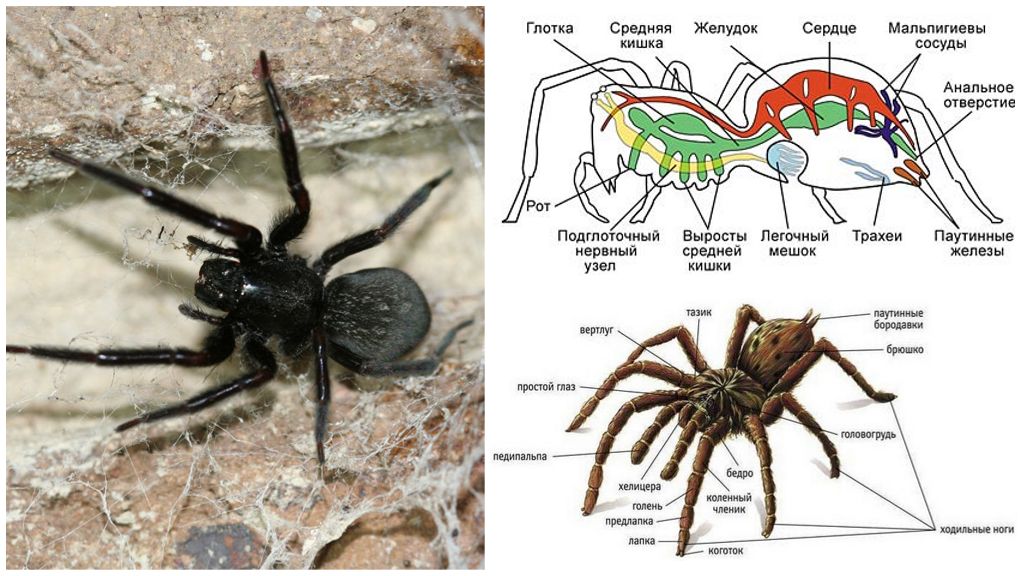
The respiratory system has a peculiar appearance. Lung bags have plates and look like books. The breathing openings that open the lungs are equipped with protective covers.There are also long tracheal tubes that transport oxygen from the openings to the organs of the spider body.
Being a predator, the spider has a well-developed central nervous system and a significant volume of the brain. There are 2 nerve nodes in the cephalothorax of the arthropod, from which many nerves diverge leading to the spider organs. These nodes are the brain of the animal.
Interesting!
The brain volume occupies 20-30% of the total volume of the cephalothorax.
Food spiders
Although spiders are obligate predators and they catch their prey on their own, but they have no teeth. To eat a prey, they need to dissolve its tissues and get a nutritious broth. This goal is served by spider venom, which the animal injects into the victim through hollow chelicera, achieving two goals: to kill still living prey and get a nutrient solution. Therefore, all spiders are poisonous, but few of them are dangerous to humans.
What are the spiders
Arthropods occupied almost all levels of living space on the planet. They can be found in burrows, on the ground, on bushes, on trees of any height. They did not master only air. And then conditionally. Some species spread on cobwebs, which they release in windy weather. A spider on a web flying in the wind is able to overcome huge distances.
Unofficially, spiders can be divided into groups:
- norns;
- ground;
- sub-breast;
- woody.
The familiar round web in the form of a “target” belongs to tree spiders. Burrowing webs fix the soil so that their home does not collapse. Ground "spread" a web on the ground, weaving pieces of soil into it. They use their web as a signal system. Subcubic live at the base of the bushes and weave a web in the form of a hut, which is masked by branches and soil.
Interesting!
Silver spider - the only species living in the water.
Funny classification
Among fans of large tarantulas, there is an interesting division of pets into categories according to their speed characteristics:
- For beginners. Slow spiders that they like to demonstrate on video. These arthropods sit quietly in the palm of their hand, and if they try to escape, they move slowly.
- For advanced. If the spider of this group decided to escape, then the owner can only notice the direction in which the animal disappeared.
- For professionals. The escape of a spider is noticed by its absence at the place where he just sat. Where has gone, is known only to the arthropod itself.
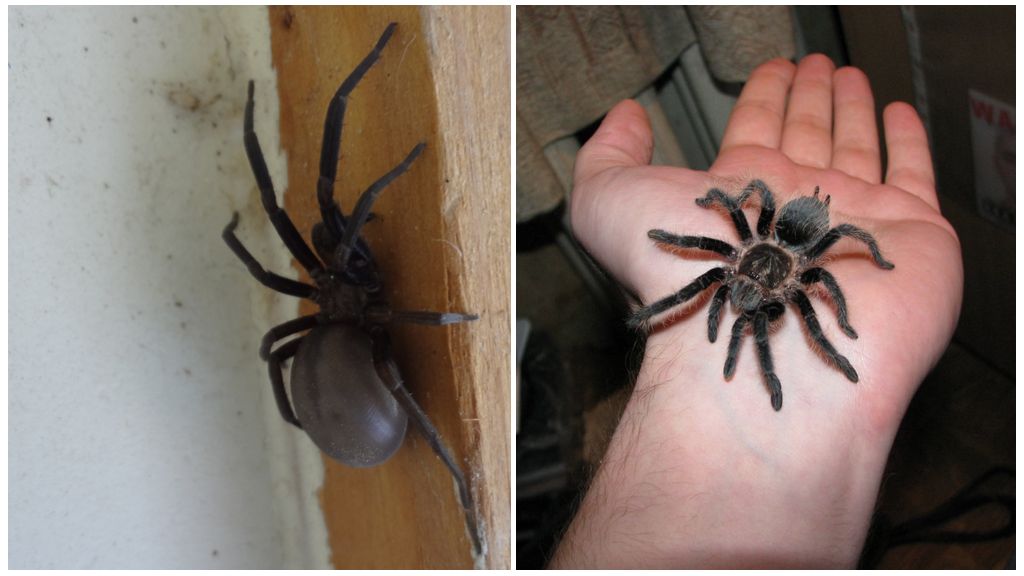
The last group suggests that not all breeds of spiders have been discovered by scientists. It’s hard to see a fast spider if you don’t even suspect that it is here.
Deadly poisonous
In most cases, spiders do not pose any danger to humans. Is that annoying weaving cobwebs in the corners. But the classification according to the degree of toxicity is more practical, since there are some types of deadly even for humans.
For real poisonous spiders:
- black widows, including karakurt;
- Brazilian runner spiders;
- brown hermit spider.
Black widows are named so because the female eats the male after mating. Spiders of this genus are common on all continents. They catch prey using the web as a lasso. Not all species of this genus are dangerous to humans. The greatest celebrity was an American black widow.
North American Black Widow
There are 5 species of black widows on the northern continent. The main color of these spiders is black with red spots on the abdomen.
Important!
Not all black widows have black coloring.
This kind of spiders can be distinguished by a characteristic line: long legs, which are clearly visible in the photograph.
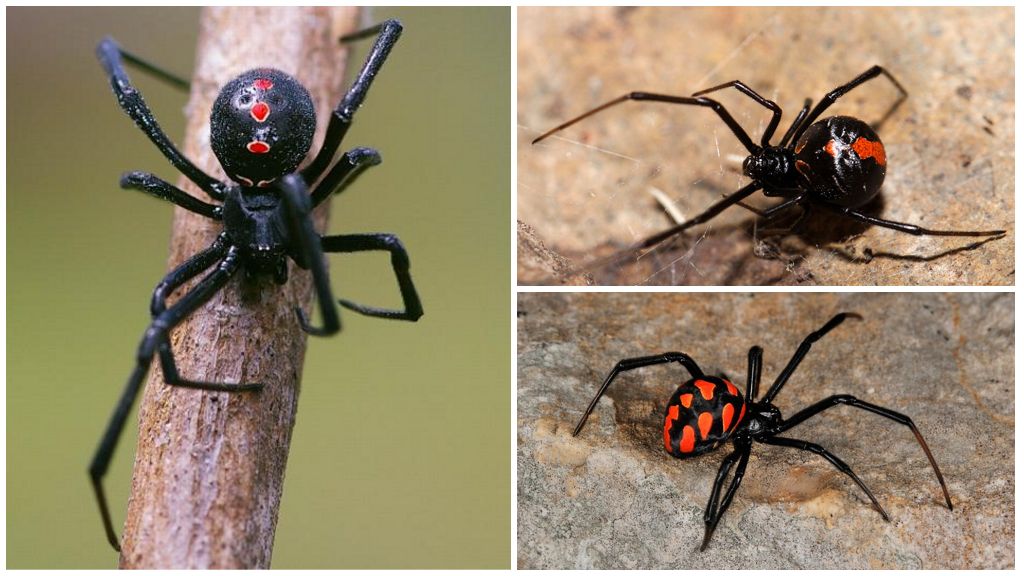
Spider bite Feels like a prick pin. After half an hour, muscle cramps appear, spreading throughout the body. Before the serum, 5% of the victims died from black widow bites.
South American Black Widows
In South and Central America, 8 species live.The life and appearance of these populations are poorly studied, since the places where these spiders live are sparsely populated and have not been seriously studied.
Karakurt
18 species of varying degrees of toxicity live in Eurasia and Africa. In Eurasia, black widows spiders are called karakurt.
The name of the spider is of Turkic origin and in Russian means "black worm". The "classic" black karakurt Latrodectus tredecimguttatus lives in the southern regions of the continent, including the Mediterranean and Crimea. In connection with global warming, it began to come across in Azerbaijan, Altai and the Novosibirsk region. The ideal habitat for this Karakurt spider is warm autumn and hot summer.
The name and photo of the spiders are somewhat inconsistent: this type of karakurt has large red spots on the dorsal side of the abdomen. Coloring can vary greatly: Eurasian species interbreed and the spider can be pure black.
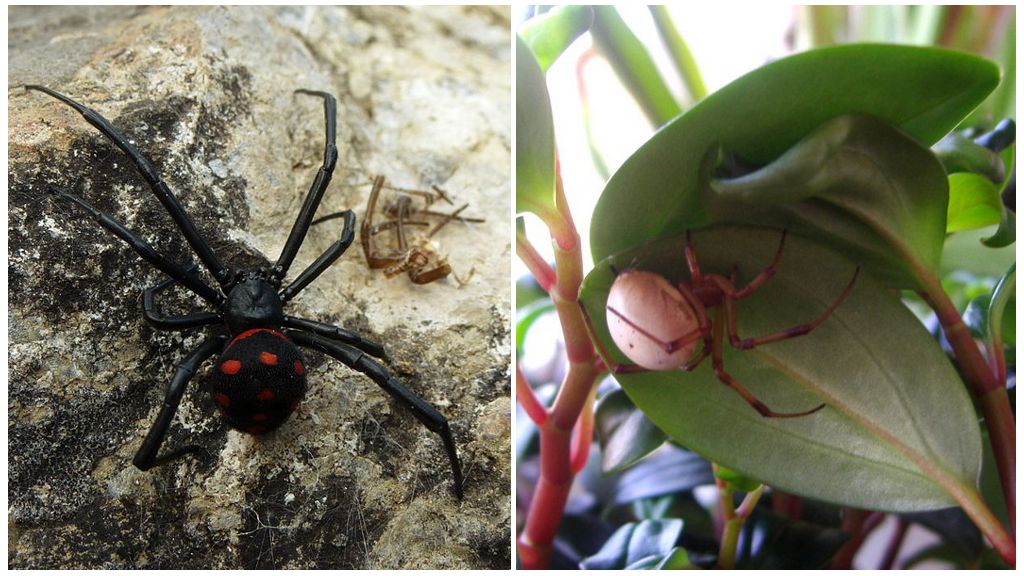
On a note!
There is a white karakurt (Latrodectus pallidus). Since white karakurt look uncharacteristic for these types of arthropods, you can not pay attention to them. White karakurt are less toxic than black ones, but their bite can cause trouble for children or people suffering from allergies. The habitat is combined with the territory on which black karakurt lives.
Oceania and Australia
Three species, one of which was imported into Southeast Asia. The Australian black widow is also considered one of the most dangerous species.
Latrodectus geometricus
A species of black widow common on all continents. The color on the dorsal side is brown. There is a red spot on the underside of the abdomen. Paws are yellow-brown with black stripes at the folds. Of all black widows, the least toxic and dangerous only for children and the elderly.
Brazilian wandering spider
Until 2010, the black widow was considered the most poisonous spider, but brazilian spider soldier took away the prize cup from her. The genus of Brazilian wandering spiders has 8 species. The distribution area is very limited: the tropics of South and Central America. The hunting method is active. The web is not woven.
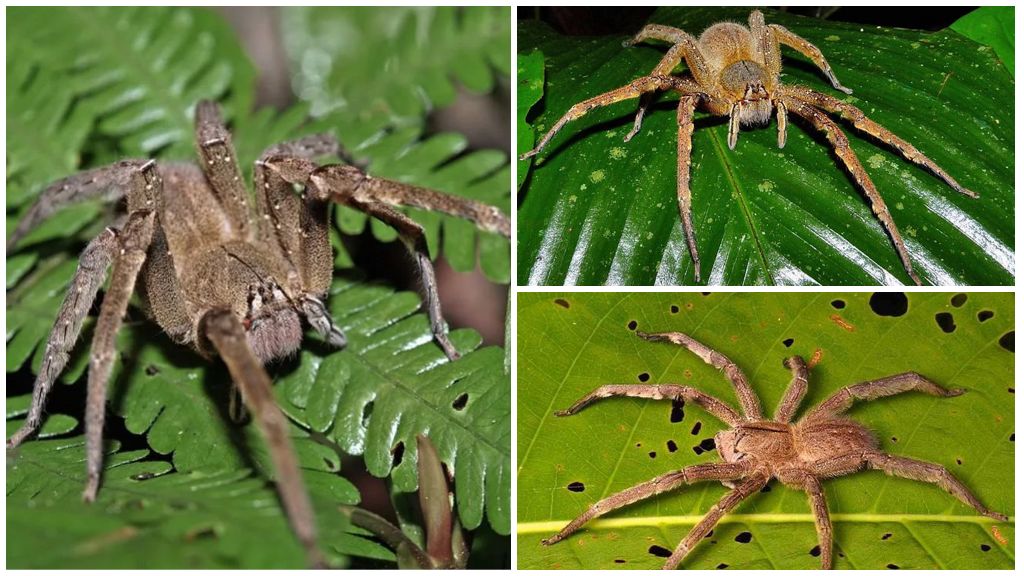
Interesting!
The latter species was discovered only in 2001.
The poison of soldier spiders in the final stage causes muscle paralysis and suffocation. When poison enters the bloodstream, in 85% of cases after a bite, cardiac arrest occurs.
Hermit spider
It lives on the North American continent. The leg span can be 6-20 mm. Color brown, dark yellow, gray. One of the species in which the eye is less than 8. U the hermit only 3 pairs that can be seen in the photo of the cephalothorax close-up.
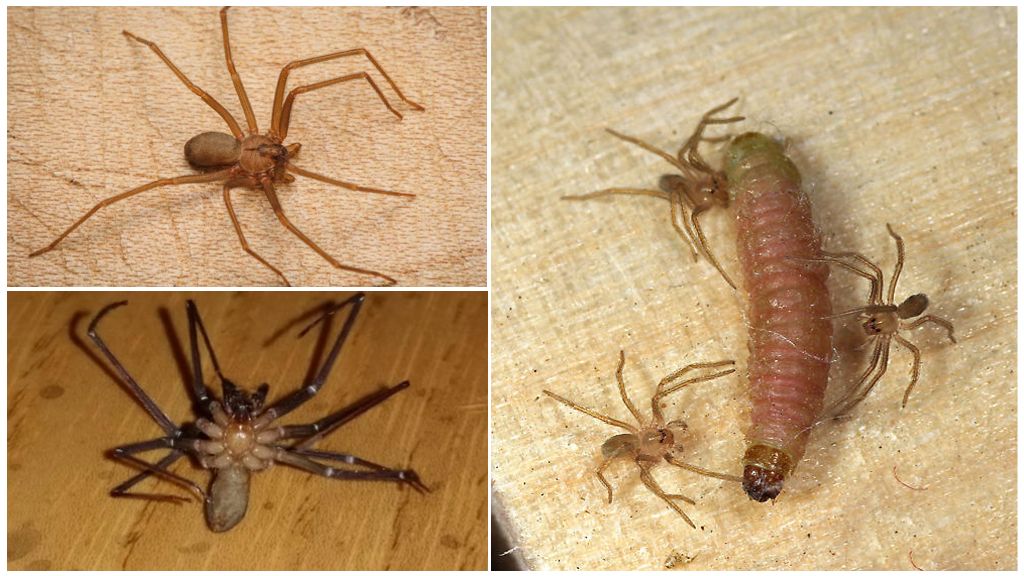
He leads a nocturnal lifestyle, hiding under roots and stones during the day. The hunting method is active, but weaves nets that it uses as a shelter. Likes to settle in a person’s housing. Can accidentally get into bed at night. If pressed down, it will bite.
The consequence of bites is the development of a necrotic ulcer. Heals the affected area for 3 years. A bite can lead to death if the victim is a child or a person with a weakened immune system.
Spiders of medium toxicity
The bite of such arthropods does not lead to death, but can bring trouble in the form of swelling of the limbs and a painful bite. These types include:
- banana
- tarantulas;
- spider sak;
- spider wasp.
Bites of these animals cause local irritation. With a very large dose of poison, swelling of the limb is possible.
Banana
Large wood orbiting spidersspinning the largest cobwebs. They have several names:
- banana spider;
- giant tree spider;
- gold spinner.
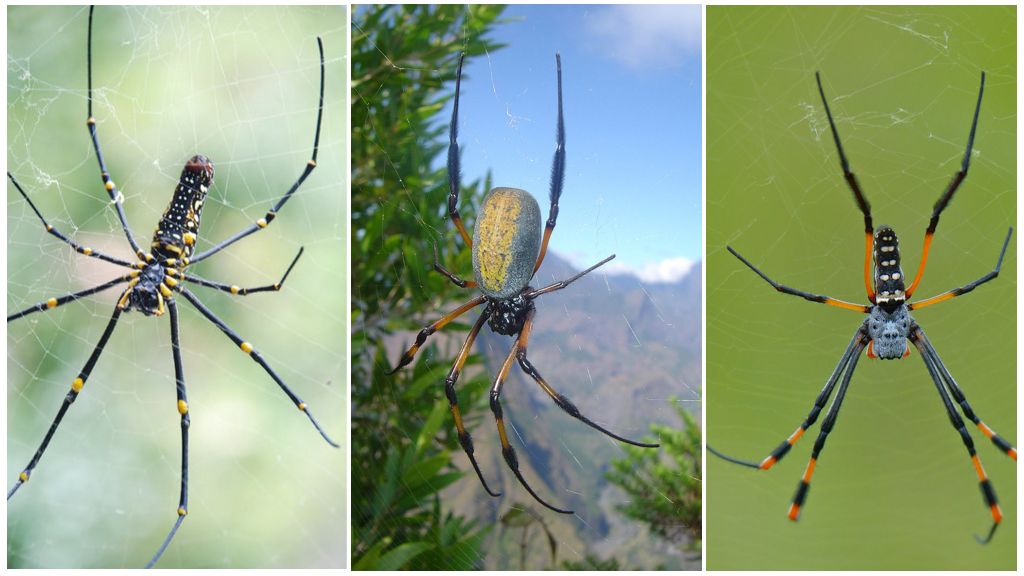
Body length 1-4 cm. Paw span 12 cm. Poison for humans is not fatal. A spider bite causes a local allergic reaction: burning, the appearance of blisters, redness of the bite. Symptoms go away during the day.
Tarantulas
Belong to the family wolf spiders. Two species are best known: South Russian and Apulian tarantula.The common name of the South Russian tarantula is misgir spider. Large arthropods, not weaving hunting nets. They lead a nocturnal lifestyle, attacking small invertebrates and other spiders. During the day they hide in vertical burrows with a diameter of 1-1.5 cm and a depth of 0.6 m. Animals have a gray protective color. The abdomen is covered with bristles. Paws of medium length.
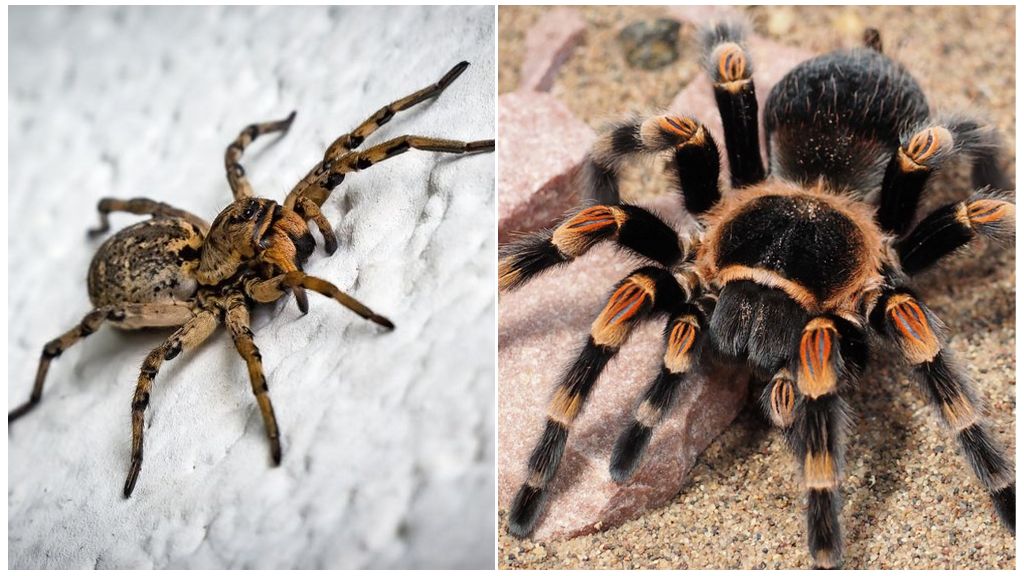
Distributed in the southern dry steppes of the Eurasian continent. Tarantulas are especially poisonous in the spring after hibernation, until they have time to squander the poison. But you have to try hard to get a bite from this arthropod: first remove it from the hole, and then grab it with your bare hand. Defending tarantula capable of a vertical jump, but at the first opportunity he will try to hide.
Interesting!
In English-speaking countries, tarantulas are called large tarantulas.
Spider sak
The second name is yellow heiracantium. Originally an inhabitant of the southern regions. But the abnormal heat led to the fact that arthropod began to be found in Central Russia. The spread is facilitated by the unhealthy addiction of sake to the smell of oil. He often gets between the tubes of the motor system of the car. Clogs the ventilation holes with its web.
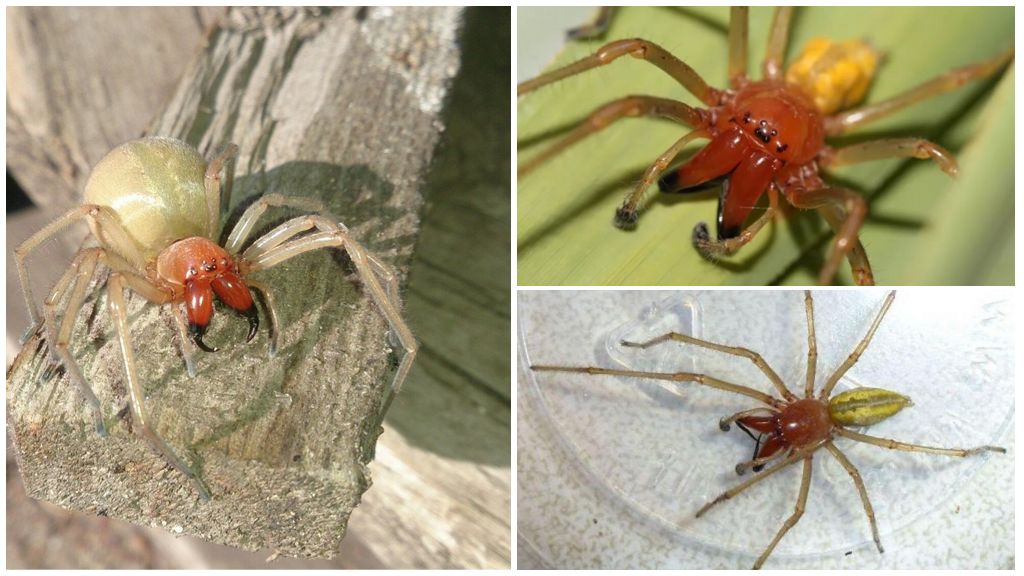
Small animal: 0.7-1.5 cm. Paw span reaches 2.5 cm. The color is yellow-brown. Has impressive chelicera with very long needles. This device is for active night hunting. What sak looks like, you can see the photo of the spider below.
Saka poison causes soft tissue necrosis. Other signs of poisoning can be nausea, headache, fever. The bite site becomes inflamed.
Argiope
She's a spider-wasp. Belongs to the family of orbiting spiders. Wasp got its name for the characteristic coloring of the abdomen. By the number of species, it is second only to horse spiders and linifiids. The range of argiopes is limited to 52 ° N.
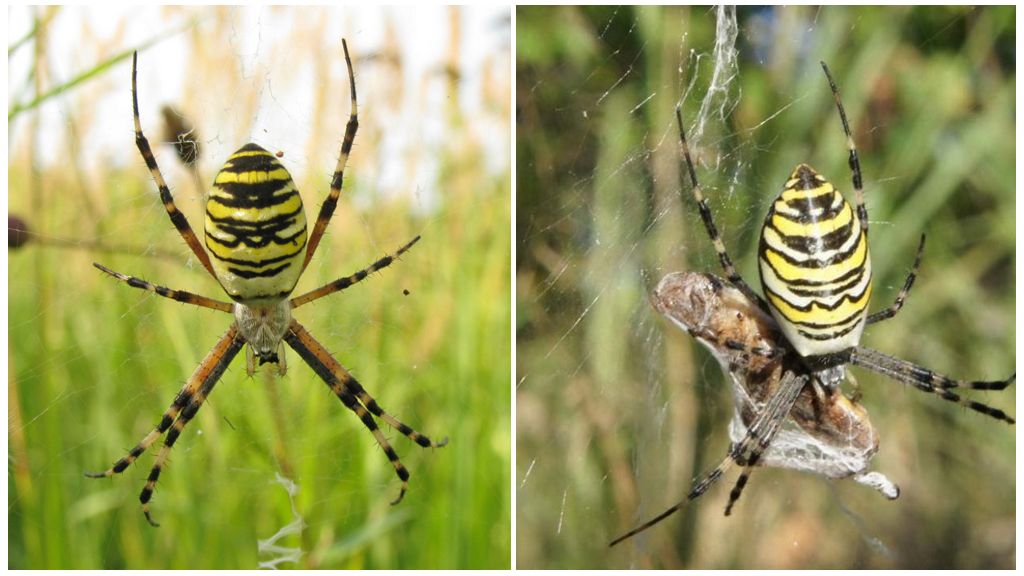
On a note!
Argiope - one of the species that mastered the flight on the cobweb.
Passive hunting. In the twilight weaving round nets. It feeds on flying insects. The bite is painful. May cause local irritation.
Safe spiders
Representatives of this group either cannot bite through human skin, or their poison is too weak to cause harm. These spiders include:
- tarantulas;
- crosses;
- haymaking;
- brownie;
- horses.
Most spiders are not interested in humans. They live in nature and desire only one thing: that no one touches them.
Tarantulas
The largest spiders. Champion the largest arachnids in the world is a goliath spider: a tarantula, whose body length reaches 10 cm. goliath 28 cm. The body is covered with thick red-brown bristles. A tarantula is not dangerous to humans, but falling bristles can cause an allergic reaction.
Crosses
Crosses - large spiders with a very large abdomen of a triangular shape. On the back there is a characteristic pattern in the form of a cross, which gave the name to the entire family of spider-crosses. Inhabitant of gardens, forests, parks and other green spaces. Conducts a passive hunt for insects, weaving circular nets. The cross itself makes a refuge from folded leaves.
Bites are harmless. Even a child feels like a light pinch. But to stop the kid from grabbing the spider with his hands, the cross is able to.
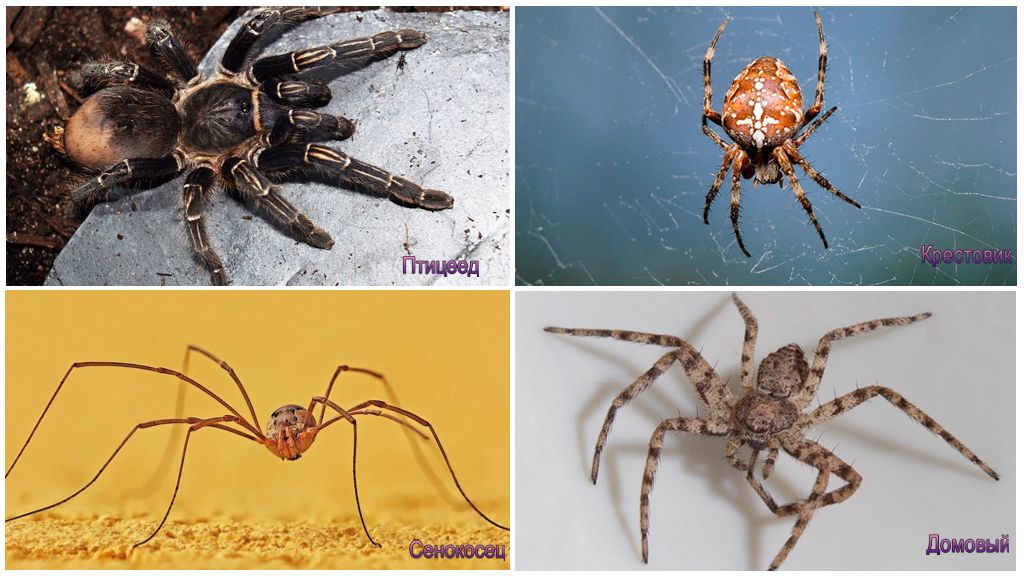
Hayers
Mowers have not become home spiders, but “domesticated” and in no way want to leave a person’s housing. For people, they are completely safe and cannot even pinch. Outwardly, the grassland is similar to a rhino-bug, but has an elongated body, divided into two parts. The bug has a round body.
On a note!
Haying spider weaves a messy web in all corners with murderous industriousness and annoys people not with bites, but with the need to constantly take away the fruits of his labors.
Brownie
Belongs to the family funnel spiders. Distributed everywhere. Often settles in a person’s home. Female house spider size 7-12 mm, male 6-9 mm. The color is brown. Funnel network weaves.It’s not aggressive towards people, but if you put your finger in his shelter, it can bite. There will be no consequences from a bite.
Horses
Horse spiders - one of the largest families. Distributed everywhere except Greenland. Spiders of this family are capable of jumping and actively hunting in the daytime. The horses have a well-developed hydraulic system that allows them to change blood pressure and expand their limbs. Thanks to this device, they can make jumps that are many times larger than their own size.
Interesting!
The family of horses is remarkable in that it has the only species of spider - a vegetarian. Bagira Kipling lives in Central America and feeds on acacia genus Vachellia. But this spider is not a pure vegetarian. During a period of drought, they can switch to food by individuals of their own species.
Peacock spider
The original Australian endemic from the family of horses. A small spider of very bright coloring. Title peacock spider received for a complete copy of this bird: a bright male and a modest female. Caring for the female, the spider "spreads its tail." He spreads the side shields of the abdomen and raises his hind legs with the abdomen up. In the absence of a female, spiders wrap shields around the abdomen.
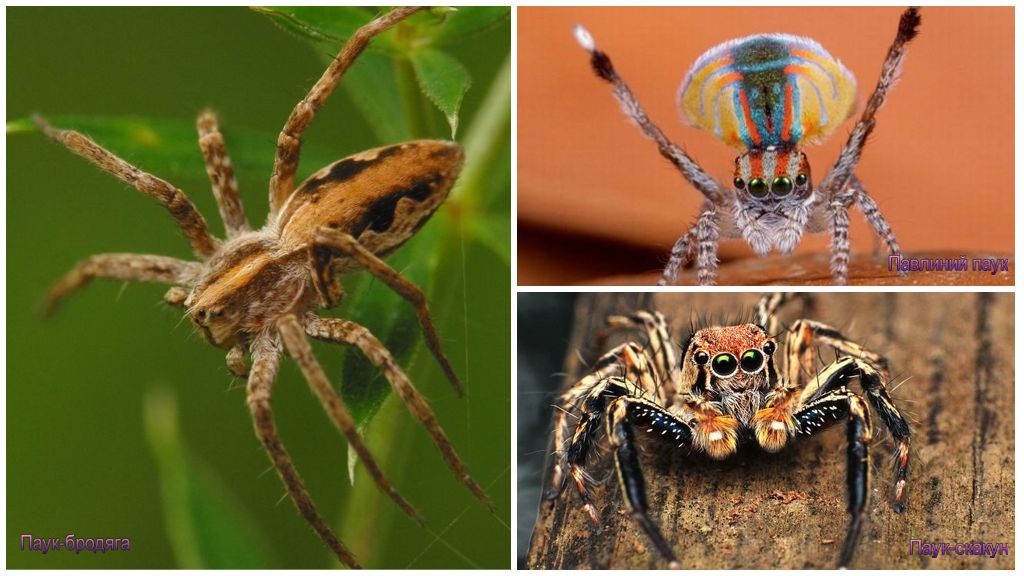
Tramp
Tramp Spiders got their name because they do not weave nets and hunt, attacking prey from an ambush. The structure of the eyes and hunting methods are similar to wolf spiders. The female uses a web for weaving a cocoon, in which she seals the eggs. The female carries the cocoon with her on her back.
Hunter
Belongs to the family of sparassids - hunter spiders. The body can reach a length of 2 cm. Color variations from tan to dark brown. On the sides of the body is a white stripe. Distributed in a temperate climate in Eurasia. It lives on the banks of water bodies. Distinctive feature hunter spider - the ability to move on water and even dive in case of need. The second name of the hunter is a fisherman, since a spider can catch and kill small fish. He does not care about a person.
Green spider
It is impossible to determine the toxicity of this arthropod, since the nature of the species "green spider" does not exist. Different animals from different genera have this color:
- horse spiders;
- hunter spiders;
- lynx spiders.
All these green spiders there is in Russia. To decide how dangerous the bite of a green spider is, you first have to find out which family it belongs to.
Crab spider
It’s also difficult to determine which one crab spider can be talked about. Arthropods from three families have the ability to move sideways at once:
- Neocribellatae;
- Thomisidae (sidewalk spiders);
- Philodromidae (isopods side walkers).
On a note!
There is no separate type of “crab spider”, but all spiders from these three families are not dangerous for humans.
Arachnids
In the arid regions of Central Asia and Africa, large arthropods live, which are often mistaken for spiders. These are salpugs. According to tracing paper from English, they are also called camel spiders. But unlike spiders, salpugs have teeth, they do not have spider glands and are not poisonous.
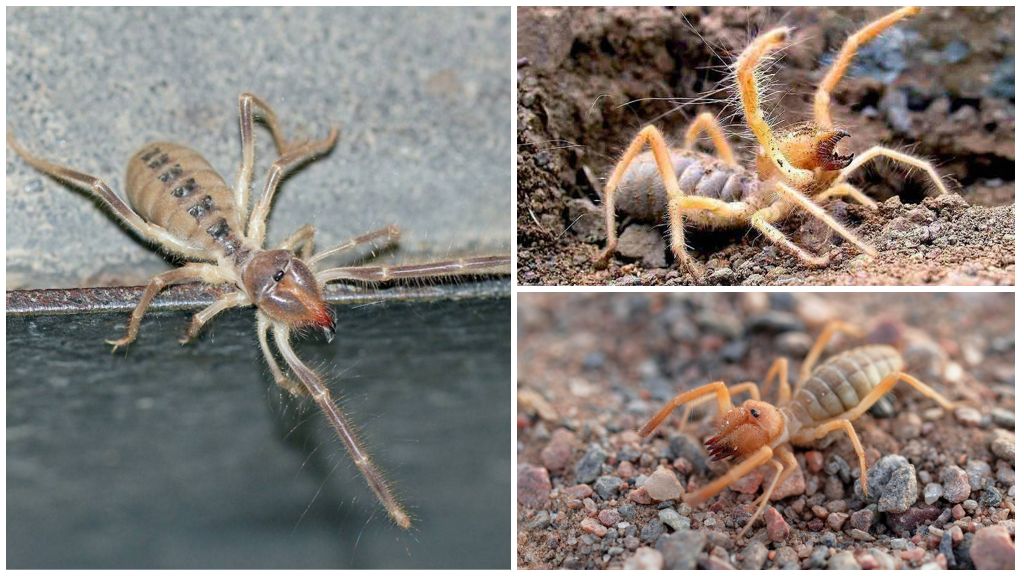
Solpuga is a large animal that can catch and kill not only invertebrates, but also small lizards. The large salpug chelicera are so powerful that they can bite through a human nail. No real spider is capable of this. Although the salpugs have no poison, their bite can be very dangerous. Particles of decaying flesh remain on the chelicera of these arthropods. After a bite, you can get blood poisoning.
Spiders cause in many arachnophobia, although they are one of the most harmless and useful inhabitants of the planet. Fans of spiders consider them “kittens”.
